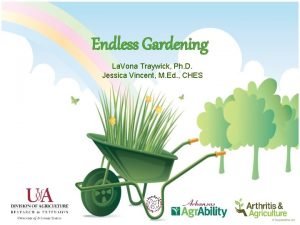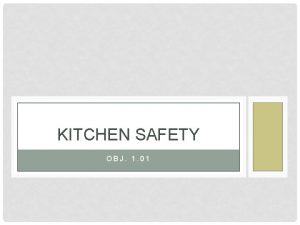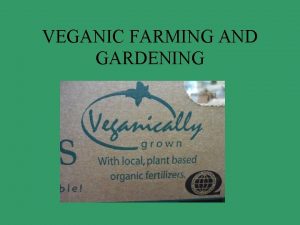KITCHEN GARDEN Kitchen or home gardening is growing







- Slides: 7

KITCHEN GARDEN Kitchen or home gardening is growing of vegetable crops in residential houses to meet out day to day requirement of vegetables of a family all the year around. The advantages of kitchen garden: • Efficient and effective use of land for growing essential vegetables for the use of a family. • Saves some money as fresh vegetables are quite costly in the market. • Kitchen gardening ensures a continuous supply of vegetables throughout the year. • We get pesticide residue free vegetables • Constitute a very healthy hobby as the spare time of the family is utilized well. • It develops a sense of co-operation amongst the family members and also good training/education to the children.

Layout and cropping plan • South-east aspect is preferred to have maximum sun light. • For kitchen garden land should be selected in the backyard of the house (easy to work and make use of kitchen waste water). • The shape of kitchen garden should be rectangular and a size 25 × 10 m is sufficient to meet the daily demand of vegetables for a family of 5 persons. • Layout of the garden should be such that it looks attractive and allow access to all the parts. The land should be laid out in small plots with narrow paths. • The most suitable vegetables for kitchen gardening are those which produce high yield per unit area. Beans, cabbage, carrot, leek, lettuce, onion, parsley, pea, pepper, radish, spinach, and tomato are desirable home garden crops.


Plot No. 1 Cabbage (Golden Acre) Oct/Nov-March French bean (Phalguni) March/April-June Asparagus bean(Palam long bean) June-September Plot No. 2 Late cauliflower (PSBK 1) +Knolkhol (Palam Tender Knob) Oct-March Cow pea (Pusa Phalguni)March-June Tomato (Palam Pride)June-October Plot No. 3 Mid cauliflower (Pusa Subhra)+ Methi (Palam Soumya/Pusa Kasuri) Aug end/Sept- Nov/Dec Potato (Kufri Jyoti) + Sarson & Corriander Dec/Jan-May Okra (P-8/ Palam Komal) June- August Plot No. 4 Onion (Palam Lohit) Dec/Jan-May Brinjal (Arka Nidhi & Hisar Broccoli (Palam Shyamal) Samridhi) +Sarson & Palak June-Sept-Dec Plot No. 5 Onion (Palam Lohit)Dec/Jan-May Pole bean (SVM-1/ Luxmi)June-Sept Plot No. 6 Garlic (GHC-1) Oct-May Chilli (Surajmukhi) May/June-Sept Plot No. 7 Potato (Kufri Giriraj)Dec-May Bell Pepper( California wonder) June- August/Sept Cabbage (Golden Acre/Pusa Mukta) + Lettuce Sept-Dec Potato (Kufri Chandermukhi) + French bean (Contender)

Plot No. 8 Bell Pepper (CW) March-May/June Tomato (Palam Pride) June-Oct Broccoli (Palam Haritika/Palam Vachitra/Palam Kanchan) Oct/Nov-March Plot No. 9 Tomato (Palam Pink) April-July Kharif onion (N-53 sets) Aug- mid Nov Late Cauliflower( Pusa snowball -1) & Cabbage ( Pusa Mukta/ Golden Acre) + Garden Pea (Pb 89) Nov-March) • Climbing type vegetables like cucurbits, pea, beans etc. can be trained on the fences. • Staggered sowings of a particular crop at short intervals should be done to ensure regular supply of vegetables. • Quick growing fruits trees like papaya, banana, lime etc. should be located on one side of the garden, preferably on the northern side so that minimum shading effect is there on the vegetables. • Ridges which separate the beds should be utilized for growing root crops like radish, turnip, beet and carrot.

• Early maturing crops should be planted together in continuous rows so that area may be available for growing next crop. • The inter-space of some crops which are slow growing and take long duration to mature like cabbage, cauliflower, brinjal should be used for growing some quick growing crops like radish, turnip, palak and lettuce.

• Ridge 1 -3: Turnip (PTWG) followed by radish (Japanese White) • Ridge 4: Beet Root (Detroit Dark Red) followed by colocasia (Local) • Ridge 5 -6: Carrot (Nantes/Pusa Kesar) followed by colocasia (Local) • Ridge 7: Radish followed by colocasia • Perennial Plots • Turmeric: 6 rows; banana and papaya 3 in a row; Curry leaf 1 plant and asparagus- 3 small rows • Other space: • Grow rows of leafy vegetables, ginger etc. on both sides of the path. • Pole beans should be trained on the gate side of fence. • Pea in winter followed by cucurbits in summer can be trained on remaining three sides of the fence.













